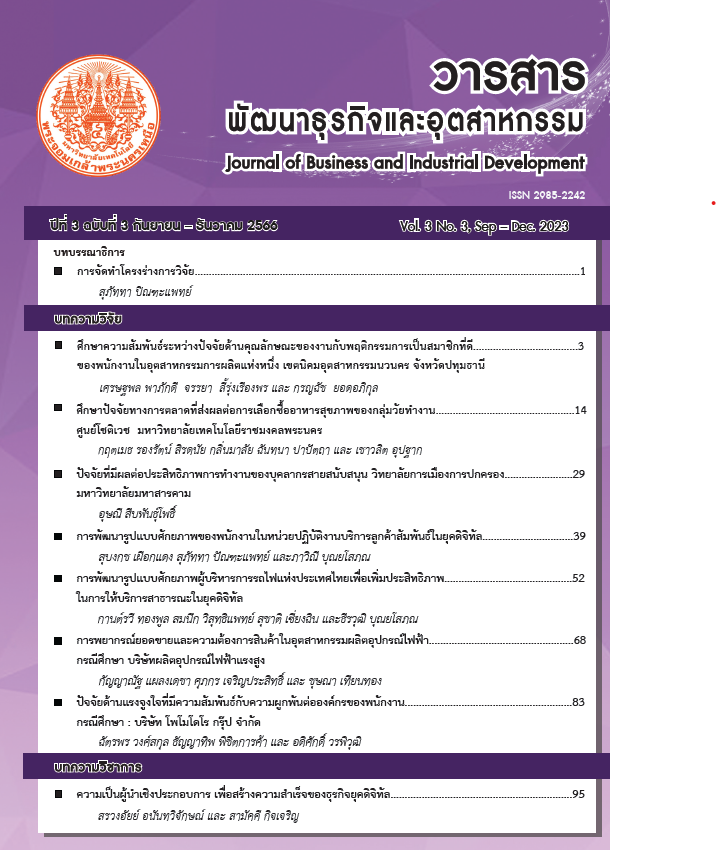Development of Customer Service Employees’ Potential Model in Customer Service Operation Units in the Digital Age
Keywords:
Model Development, Employees’ Potential, Customer service, Operation UnitAbstract
The objectives of this research were 1) to study the components of customer service employees’ potential in the digital age, 2) to develop a potential model of customer service employees in the digital age, and 3) to create a potential development manual of customer service employees in the Digital Age. This study integrated the methods of qualitative and quantitative researches. The participants were customer service representatives of customer service operation units of organizations, customers using the services and experiential experts in service business.The research tools were interview questions and questionnaires. The qualitative data were analyzed by using content analysis and the quantitative data were analyzed by using statistics of frequency, mean, percentage, standard deviation, and factor analysis. The results showed that the potential of customer service employees in the Digital Age composed of 70 variables. The developed potential model of the customer service employees in the Digital Age comprised 5 key components with 17 sub-components. The key components were as followed: 1. Organization, 2. Performance operation, 3. Services, 4. Information technology and Innovation, and 5. Employees’ attributes. The manual for potential development of customer service Employees in the Digital Age consisted of 2 parts: Part 1: Introduction and Part2: Guideline for employees’ potential development in customer service operation units in the Digital Age. Both the model and the manual were approved by the experts for the appropriateness in application to develop the employees’ potential in customer service operation units in the Digital Age.
References
Pattira, M. (2019). The Potential Development Model of Contact Center Management in the Digital Age. [Doctoral dissertation]. King Mongkut’s University of Technology North Bangkok.
(in Thai).
Chanin, D., & Wasin, L. (2019). Customer. Knowledge Management of Electronic Commerce Entrepreneur. [Master’s thesis]. Naresuan University. (in Thai).
Lawson-Body, A., & Limayem, M. (2004). The Impact of Customer Relationship Management on Customer Loyalty: The Moderating Role of Website Characteristics. Journal of Computer-Mediated Communication.
Danai, T. (2016). Human Development Strategies: Challenges for Business Success. Chulalongkorn University. (in Thai).
Wichien, K. (2023). Analytical statistics for research. Educational research news. King Mongkut's University of Technology North Bangkok. (in Thai).
Kanlaya, W. (2010). Statistical Analysis : Statistics for Administration and Research. (12th ed.).Bangkok : Department of Statistics, Faculty of Commerce and Accountancy, Chulalongkorn University. (in Thai).
Bryun, B. (2002). Essentials of Knowledge Management. New Jersey: John Wiley & Sons,Inc.
Jutharat, P. (2020). Development of New Entry Employees’ Potentiality Model for Industrial Business in the Age of Disruptive Economy. The Journal of KMUTNB. King Mongkut's University of Technology North Bangkok, 30(2), 324–332. (in Thai).
Frederick, N. (1999). The Motivation to Work. New York: John Wiley.
Zikmund, W., Raymond, M., & Gilbert, W. (2003). Customer Relationship Management: Integrating Marketing Strategy and Information Technology. Wiley.
Kannaporn, R. (2020). Personnel Potential Development in Public Relations Media Organizations in the Digital Era. [doctoral dissertation]. King Mongkut's University of Technology North Bangkok. (in Thai).
Wichai, W., & Marut P. (2019). Innovation Creation Skills Development. Bangkok : Leadership Center for Curriculum Innovation and Learning Development. (in Thai).
Paramet, W. (2021). Manpower potential development model for productivity enhancement in automotive parts industry in the digital age. Journal of Nakhon Lampang Priest College, 11(2), 16-31. (in Thai).
Wassana, S., & Jirawan, K. (2016). Human Resource Management in the Organization of the Information Age to the New Era in the Future. Veridian E-Journal Silpakorn University, 9(2), 1901-1911. (in Thai).
Panya, P., Supatta, P., & Sakarin, Y. (2020). Model Development of Product Developer Potentiality in Industrial Electronics. The Journal of King Mongkut's University of Technology North Bangkok, 30(3), 537–546. (in Thai).
Downloads
Published
How to Cite
Issue
Section
License

This work is licensed under a Creative Commons Attribution-NonCommercial-NoDerivatives 4.0 International License.





